In the icy realms of the Southern Hemisphere, where snow and ice stretch as far as the eye can see, there exists a symphony of sounds: the enchanting world of penguin vocalizations. While these dapper, flightless birds may appear quite stoic at first glance, they’re actually quite the chatterboxes of the animal kingdom. Join us as we dive into the captivating subject of penguin vocalizations, where an array of chirps, brays, and trumpets form a complex language that these remarkable creatures use to communicate. Continue reading to discover 6 sounds penguins make and what each one means.

Penguins are social animals that live in large colonies.
©N8tureGrl/ via Getty Images
Penguins!
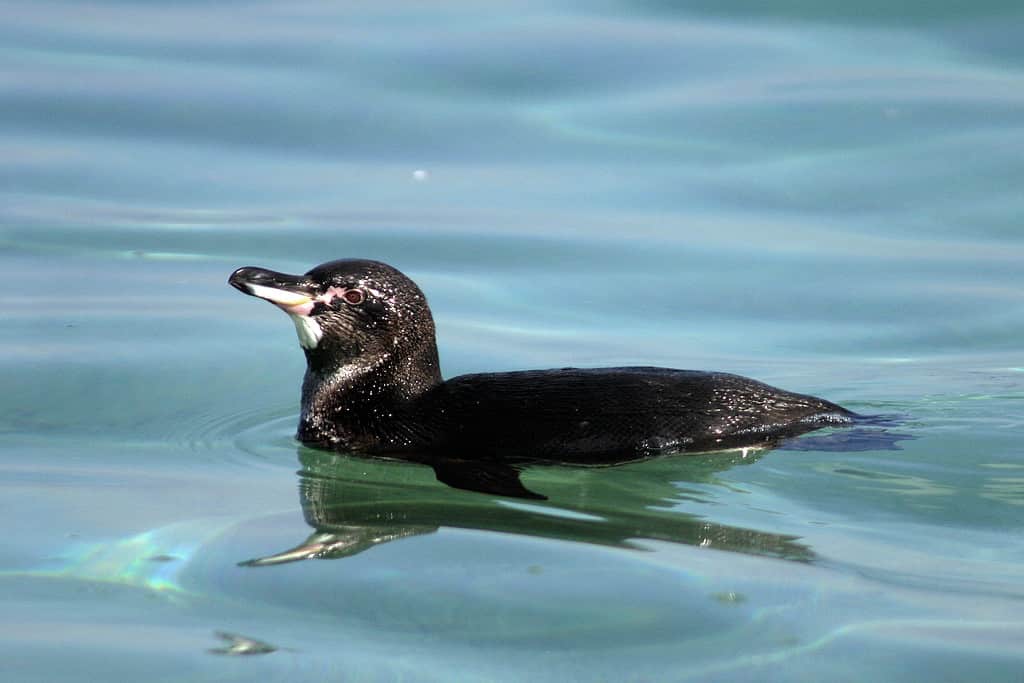
The only species of penguin found north of the equator is the Galápagos penguin (
Spheniscus mendiculus).
© Charles J. Sharp/CC BY-SA 3.0 – License
Penguins are a fascinating group of flightless birds known for their remarkable adaptation to aquatic life. All 18 recognized species of penguins belong to the family Spheniscidae, contained within six genera. Penguins are classified as Aptenodytes, Eudyptes, Eudyptula, Megadyptes, Pygoscelis, and Spheniscus. The only species of penguin found north of the equator is the Galápagos penguin (Spheniscus mendiculus). Celebrated for their unique physical characteristics, like their flipper-like wings, penguins are. Complex social behaviors and vocalizations are their hallmarks. These birds have evolved to thrive in a variety of challenging environments.
Discover 6 Sounds Penguins Make: Communication
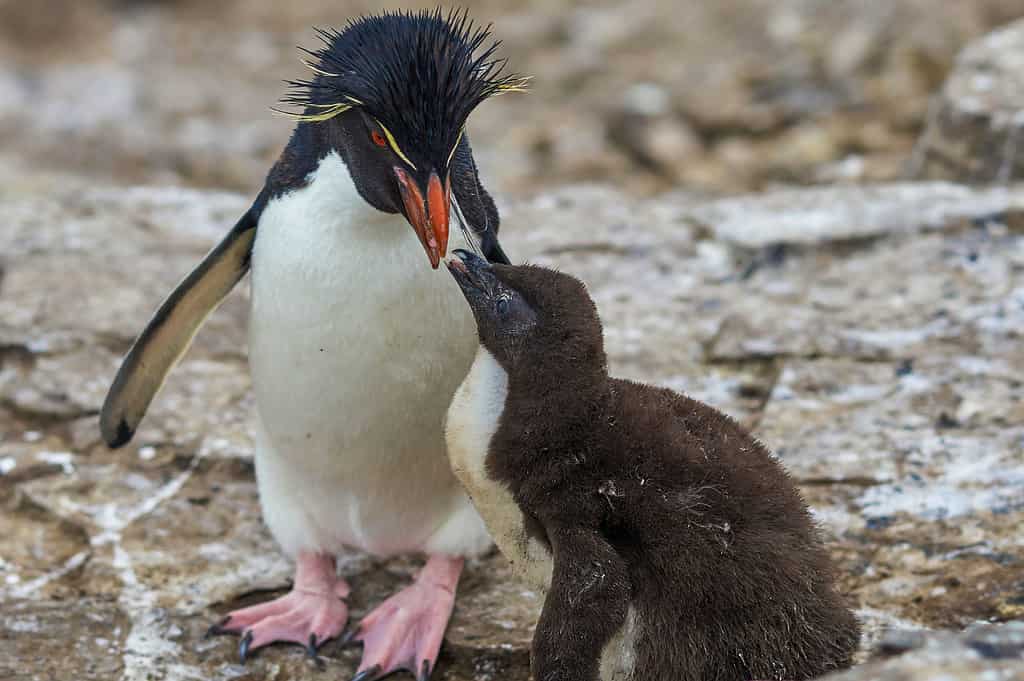
Distinct vocalizations and behaviors help parents and chicks identify each other. Pictured: A
rockhopper penguin
(
Eudyptes chrysocome) and its chick.
©Jeremy Richards/Shutterstock.com – License
Penguins, as social animals, need to communicate for a variety of reasons. Communication among penguins serves multiple functions, from maintaining social bonds and coordinating group activities to ensuring the survival of their offspring and protecting them from threats. Penguins form strong social bonds within their colonies. Communication helps reinforce these bonds, allowing individuals to recognize and interact with their mates, chicks, and colony members. Penguins often engage in activities like hunting and nesting that require organizing a group. Communication helps coordinate movements and actions, making these activities more efficient. Penguins will return to their breeding colonies after foraging at sea. They use vocal cues to help locate their specific nesting sites or colonies amidst the crowded and noisy environment.
Communication plays a role in courtship and mate selection. Penguins rely on vocalizations and physical displays to attract potential mates or signal their availability and fitness. Vocalizations and body language alert others to the presence of potential threats, helping the group react defensively.
In crowded breeding colonies, it’s essential for parents to recognize their own chicks. Distinct vocalizations and behaviors help parents and chicks identify each other. Penguins are territorial and vocalizations can assert and defend their territories against intruders.
Penguins produce a variety of complex vocalizations, and the exact number of sounds they make can vary depending on the species. Different penguin species may have distinct vocalizations, and individual penguins within a species can also produce variations in their calls.
Discover 6 Sounds Penguins Make: Trumpeting

Gentoo penguins (
Pygoscelis papua), are known for their trumpeting calls.
©Alexey Seafarer/Shutterstock.com
Trumpeting calls are a distinctive and striking feature of some penguin species. These majestic birds use trumpeting calls for various purposes, most notably during courtship and interactions between adults. These calls serve as a means of communication to establish and maintain social bonds within their colonies. The trumpeting sound is quite resonant and can carry over long distances, making it effective in the often crowded and noisy breeding colonies where penguins gather. These calls play a crucial role in helping penguins locate and recognize their mates and offspring amidst the bustling cacophony of a penguin colony.
Discover 6 Sounds Penguins Make: Braying

African penguins (
Spheniscus demersus) are brayers.
©Mike Korostelev/Shutterstock.com
Some penguin species, like African penguins (Spheniscus demersus), are known for their braying. These calls are used for communication between members of a colony, especially during the breeding season. They can help penguins locate their mates or chicks in a crowded colony. These calls are characterized by their loud and repetitive nature, often likened to the sound of a donkey braying, which is how they got their name. Penguins use braying calls to help individuals locate their mates and chicks in the densely populated breeding colonies. The distinctiveness of each penguin’s braying allows for mate recognition and plays a significant role in reinforcing social bonds and facilitating the intricate social dynamics of these charismatic birds.
Discover 6 Sounds Penguins Make: Barking
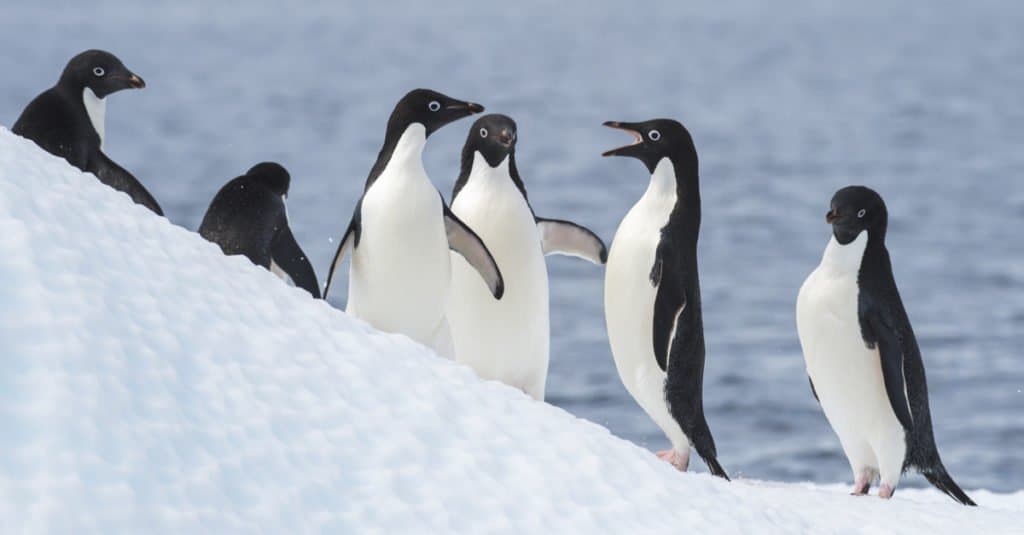
Adélie penguins
, pictured, are barkers.
©vladsilver/Shutterstock.com
Some penguin species use barking vocalizations. Barking is used to establish and defend territories. These rough vocalizations are used during the breeding season when competition for nesting sites and mates is high. Barking helps penguins convey their presence and assert dominance, often resulting in animated and noisy interactions between individuals.
Discover 6 Sounds Penguins Make: Chirping

Many penguin species, including fairy penguins (
Eudyptula minor), produce chirping and peeping sounds.
©Khoroshunova Olga/Shutterstock.com
Chirping and peeping are typically softer and more melodious than some other penguin calls and serve to establish and maintain social bonds. Many penguin species, including fairy penguins (Eudyptula minor), produce chirping and peeping sounds. Chirping is used for mate recognition, chick-parent interaction, and general colony communication. Chirping and peeping are typically softer and more melodious than some other penguin calls and serve to establish and maintain social bonds. They play a crucial role in helping penguins identify and locate their mates or chicks in the bustling and often crowded breeding colonies, ensuring proper care and coordination among family members
Discover 6 Sounds Penguins Make: Grunting
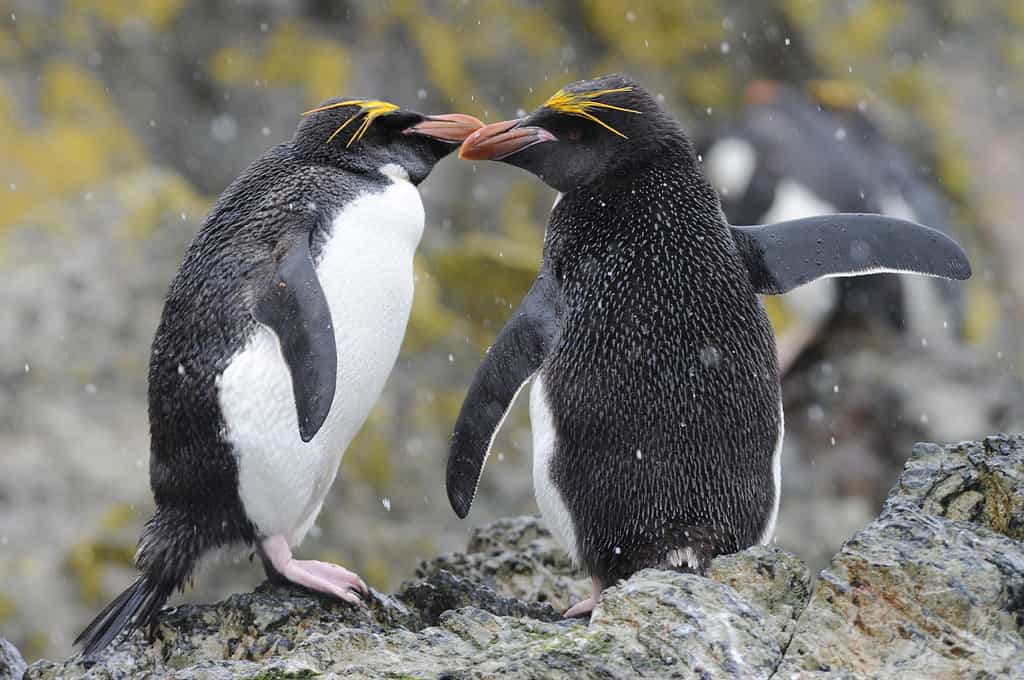
Macaroni penguins
(
Eudyptes chrysolophus) are widely regarded as the loudest penguins.
©Tsvyatko Terziev/ via Getty Images
Penguins use growling or grunting sounds during conflicts. It is often employed during territorial disputes, typically over nesting sites or personal space within a crowded colony. These grunting sounds are lower in pitch and intensity compared to other penguin vocalizations. Penguins use grunting to convey their presence and defend their territory without the need for physical confrontation. In this way, they establish dominance and maintain their position within the colony. It’s a part of their complex social behavior and hierarchy.
Discover 6 Sounds Penguins Make: Hissing
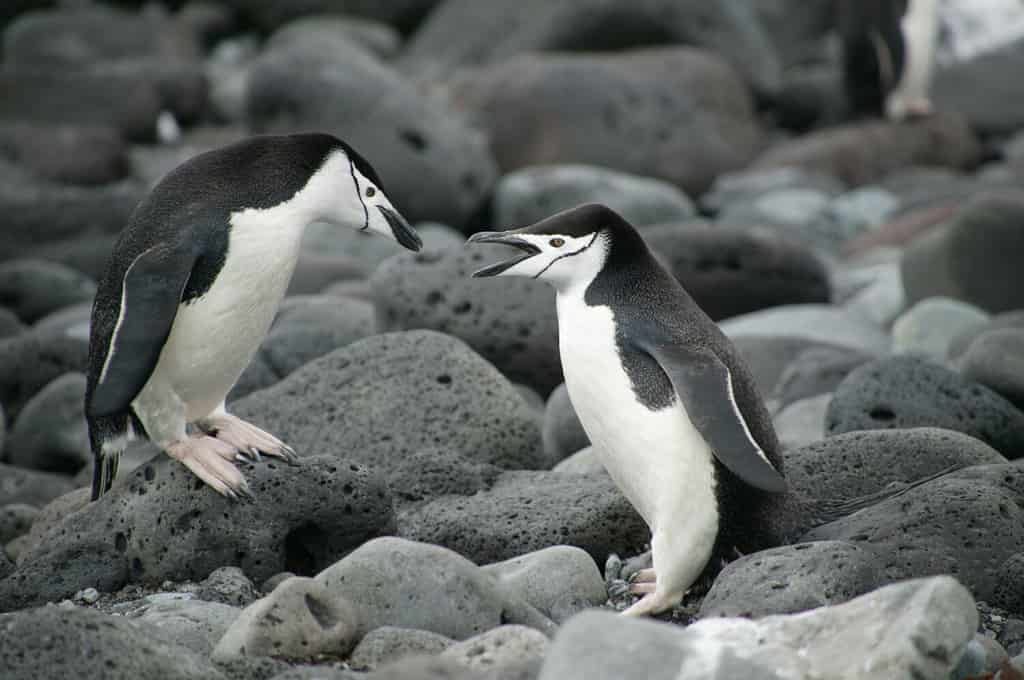
Chinstrap penguins
(
Pygoscelis antarcticus) are a confrontational species.
©Air Images/Shutterstock.com
Hissing is a vocalization used by some penguin species. It’s typically associated with aggression or as a warning signal during conflicts or confrontations. Penguins may hiss when they feel threatened or when they want to deter an approaching individual. The sound is produced by exhaling forcefully through the bill, creating a hissing noise. Hissing helps penguins avoid physical altercations by serving as a communication signal that can potentially discourage other penguins from encroaching on their territory or personal space.
Open to Interpretation
The specific meanings of these sounds can vary based on the context and the penguin species. Generally, penguins use vocalizations for purposes like mate recognition, chick-parent communication, colony location, and resolving conflicts. The exact interpretation of these sounds depends on the individual penguin’s behavior and their specific circumstances. Penguin vocalizations are complex and can be difficult to study in detail due to the challenging Antarctic environments in which many penguin species live. Researchers continue to investigate the nuances of penguin communication to better understand their social behavior and interactions.
The Sound of Silence
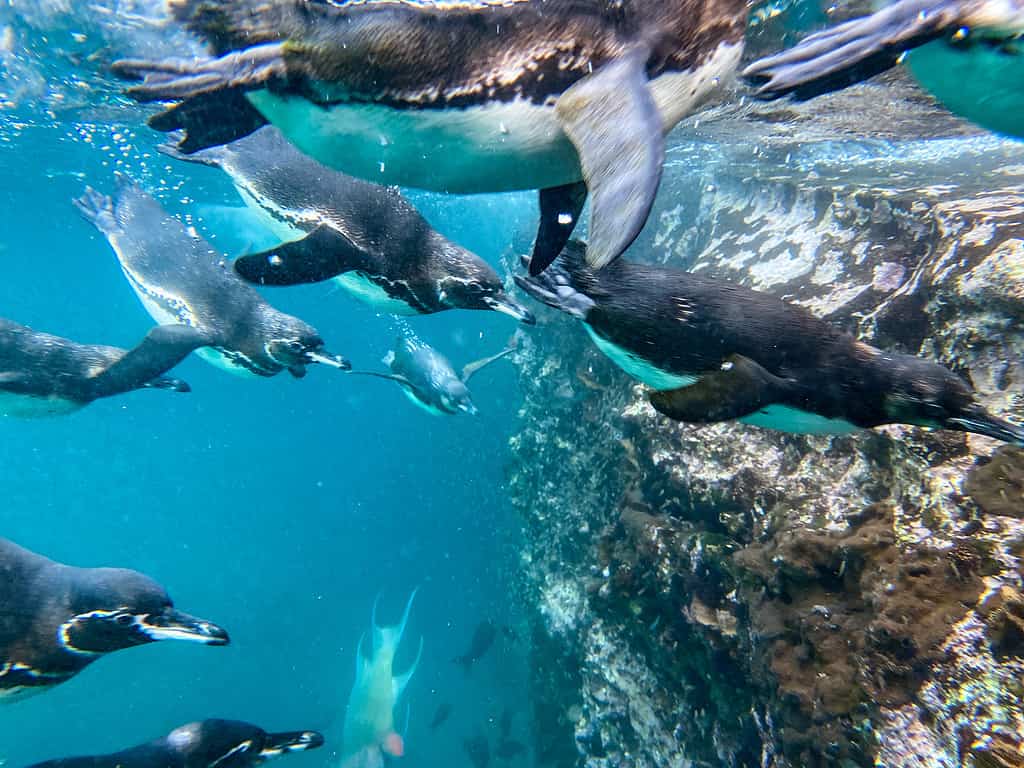
While hunting for food underwater, penguins typically do not vocalize. Silence is necessary to avoid alerting prey and predators to their presence.
©Joanne Wastchak/ via Getty Images
Though they can be quite boisterous, when penguins are quiet, depending on the context, there are specific reasons for their silence. Penguins are silent when they are resting or sleeping. During these times, they are not actively engaged in communication and are conserving their energy. Penguins go silent when they are nesting or incubating eggs. Silence helps reduce the risk of drawing unwanted attention to their nests and eggs. This behavior is essential for protecting them from potential predators.
While hunting for food underwater, penguins typically do not vocalize. Silence is necessary to avoid alerting prey and predators to their presence. Penguins are skilled hunters and rely on stealth while swimming.
In stressful or dangerous situations, penguins may become quiet. This silence can help them avoid drawing attention to themselves, minimizing potential threats. Harsh weather conditions, such as strong winds or heavy snowfall, make vocalizations less effective and may lead to quieter behavior among penguins. In such conditions, penguins conserve their energy and focus on survival.
The photo featured at the top of this post is © Dennis Stogsdill/Shutterstock.com
Thank you for reading! Have some feedback for us? Contact the AZ Animals editorial team.






